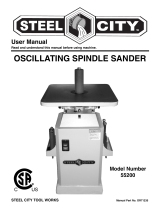
5
WARRANTY CARD
Name ________________________________________________
Street _______________________________________________
Apt. No. ______________________________________________
City _________________________ State ______ Zip __________
Phone Number_________________________________________
E-Mail________________________________________________
Product Description:_____________________________________
Model No.: ___________________________________________
Serial No. _____________________________________________
The following information is given on a voluntary basis
and is strictly confidential.
1. Where did you purchase your STEEL CITY machine?
Store: ____________________________________________
City:______________________________________________
2. How did you first learn of Steel City Tool Works?
___ Advertisement ___ Mail Order Catalog
___ Web Site ___ Friend
___ Local Store Other_______________________
3. Which of the following magazines do you subscribe to?
___ American Woodworker ___ American How-To
––– Cabinetmaker ___ Family Handyman
___ Fine Homebuilding ___ Fine Woodworking
___ Journal of Light Construction ___ Old House Journal
___ Popular Mechanics ___ Popular Science
___ Popular Woodworking ___ Today’s Homeowner
___ WOOD ___ Woodcraft
___ WOODEN Boat ___ Woodshop News
___ Woodsmith ___ Woodwork
___ Woodworker ___ Woodworker’s Journal
___ Workbench Other_________________
4. Which of the following woodworking / remodeling shows do
you watch?
___ Backyard America ___ The American Woodworker
___ Home Time ___ The New Yankee Workshop
___ This Old House ___ Woodwright’s Shop
Other__________________________________________
5. What is your annual household income?
___ $20,000 to $29,999 ___ $30,000 to $39,999
___ $40,000 to $49,999 ___ $50,000 to $59,999
___ $60,000 to $69,999 ___ 70,000 to $79,999
___ $80,000 to $89,999 ___ $90,000 +
6. What is your age group?
___ 20 to 29 years ___ 30 to 39 years
___ 40 to 49 years ___ 50 to 59 years
___ 60 to 69 years ___ 70 + years
7. How long have you been a woodworker?
___ 0 to 2 years ___ 2 to 8 years
___ 8 to 20 years ___ over 20 years
8. How would you rank your woodworking skills?
___ Simple ___ Intermediate
___ Advance ___ Master Craftsman
9. How many Steel City machines do you own? _____________
10. What stationary woodworking tools do you own?
Check all that apply.
___ Air Compressor ___ Band Saw
___ Drill Press ___ Drum Sander
___ Dust Collection ___ Horizontal Boring Machine
___ Jointer ___ Lathe
___ Mortiser ___ Panel Saw
___ Planer ___ Power Feeder
___ Radial Arm Saw ___ Shaper
___ Spindle Sander ___ Table Saw
___ Vacuum Veneer Press ___ Wide Belt Sander
Other____________________________________________
11. Which benchtop tools do you own?
Check all that apply.
___ Belt Sander ___ Belt / Disc Sander
___ Drill Press ___ Band Saw
___ Grinder ___ Mini Jointer
___ Mini Lathe ___ Scroll Saw
___ Spindle / Belt Sander Other______________________
12. Which portable / hand held power tools do you own?
Check all that apply.
___
Belt Sander ___ Biscuit Jointer
___ Dust Collector ___ Circular Saw
___ Detail Sander ___ Drill / Driver
___ Miter Saw ___ Orbital Sander
___ Palm Sander ___ Portable Thickness Planer
___ Saber Saw ___ Reciprocating Saw
___ Router Other_______________________
13. What machines / accessories would you like to see added to the
STEEL
CITY
line?
____________________________________________________
____________________________________________________
14. What new accessories would you like to see added?
____________________________________________________
____________________________________________________
15. Do you think your purchase represents good value?
___Y
es
___ No
16. Would you recommend STEEL CITY products to a friend?
___
Y
es ___ No
17. Comments:
____________________________________________________
____________________________________________________
____________________________________________________
____________________________________________________
____________________________________________________
✁
CUT HERE





























